persian tiles crochet pattern pdf free
The Persian Tiles Crochet Pattern is a vibrant and unique design inspired by traditional Persian ceramics. Perfect for all skill levels, it combines stunning colors and intricate motifs to create a visually striking blanket. With its moss stitch foundation and octagon motifs, this pattern offers a creative challenge and a sense of accomplishment for crocheters worldwide. Its beauty lies in its blend of cultural inspiration and modern crochet techniques, making it a must-try project for enthusiasts.
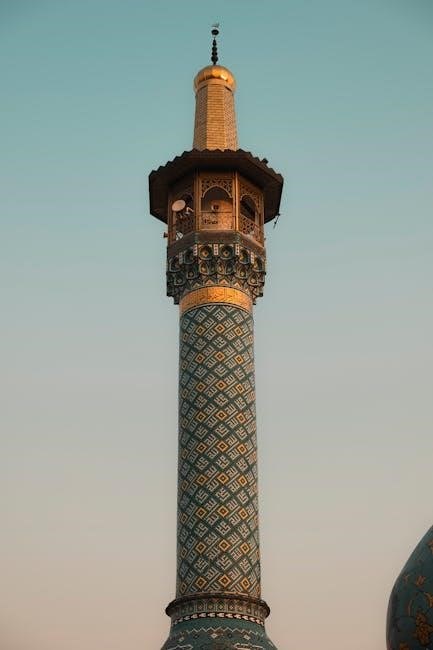
Where to Find Free Persian Tiles Crochet Patterns
Free Persian Tiles crochet patterns are available on platforms like Ravelry, Etsy, and Janie Crow’s website. Crochet blogs and Pinterest also offer inspiring free PDF downloads and ideas.
2.1. Ravelry and Etsy Downloads
Ravelry and Etsy are excellent platforms to find Persian Tiles crochet patterns, offering both free and paid options. On Ravelry, you can discover a variety of patterns, including the popular Persian Tile Blanket and the Five Persian Tile Patterns. Many designers offer their patterns as downloadable PDFs, making it easy to access and print. Etsy also provides a range of options, with sellers offering digital downloads of patterns inspired by Persian and Moroccan designs. These platforms are ideal for crocheters seeking convenience and a wide selection of styles to suit their preferences. Whether you’re looking for a detailed tutorial or a simple motif guide, Ravelry and Etsy have something for everyone, ensuring a seamless start to your crochet journey.
2.2. Janie Crow Website Resources
The Janie Crow website is a premier destination for Persian Tiles crochet patterns, offering both paper patterns and digital downloads. Their designs are inspired by traditional Persian ceramics and Moroccan textiles, blending cultural elegance with modern crochet techniques. The website features exclusive patterns, such as the Persian Tiles design, which can be purchased as a paper pattern or downloaded via Ravelry and Etsy. Janie Crow’s resources are renowned for their detailed instructions and vibrant color schemes, making them ideal for crocheters seeking a unique and inspiring project. Whether you’re a seasoned crafter or a beginner, Janie Crow’s offerings provide a rich and creative foundation for your Persian Tiles crochet journey.
2.3. Free PDFs on Crochet Blogs
Free PDFs for the Persian Tiles crochet pattern are widely available on various crochet blogs, offering a convenient way to access this stunning design. Many bloggers share detailed tutorials, step-by-step guides, and downloadable patterns, making it easier for crocheters to create their own unique blankets. Platforms like Pinterest and specific crochet blogs feature inspiration and resources, such as the “Eastern Jewel Persian Tiles” free diagram, perfect for enthusiasts. Additionally, some blogs provide free patterns with yarn and hook recommendations, care tips, and moss stitch tutorials. Exploring these blogs allows crocheters to find the perfect pattern that suits their skill level and creative vision, ensuring a rewarding and enjoyable project experience.
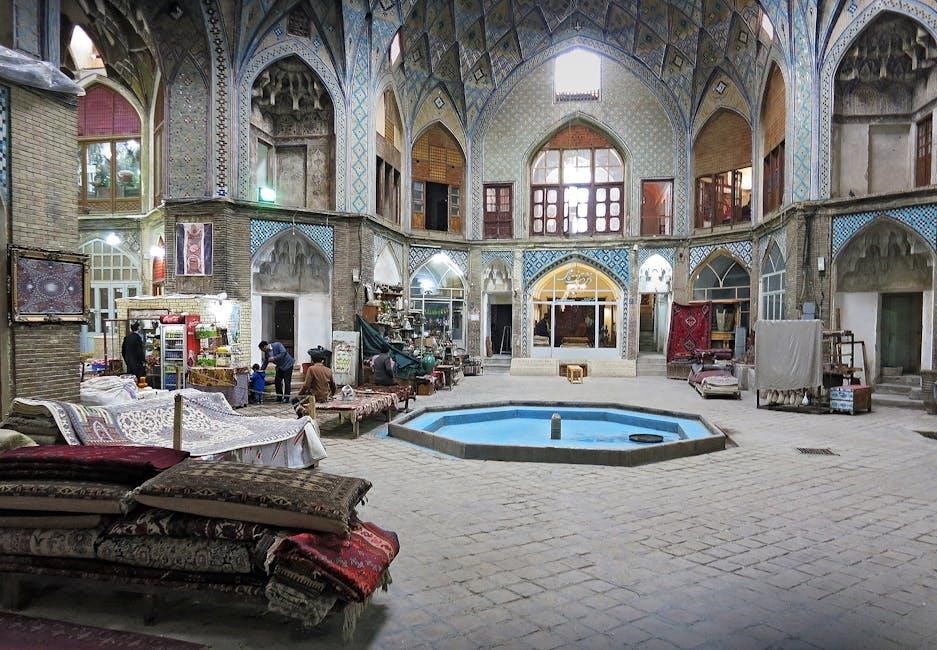
Design Inspiration for Persian Tiles Crochet
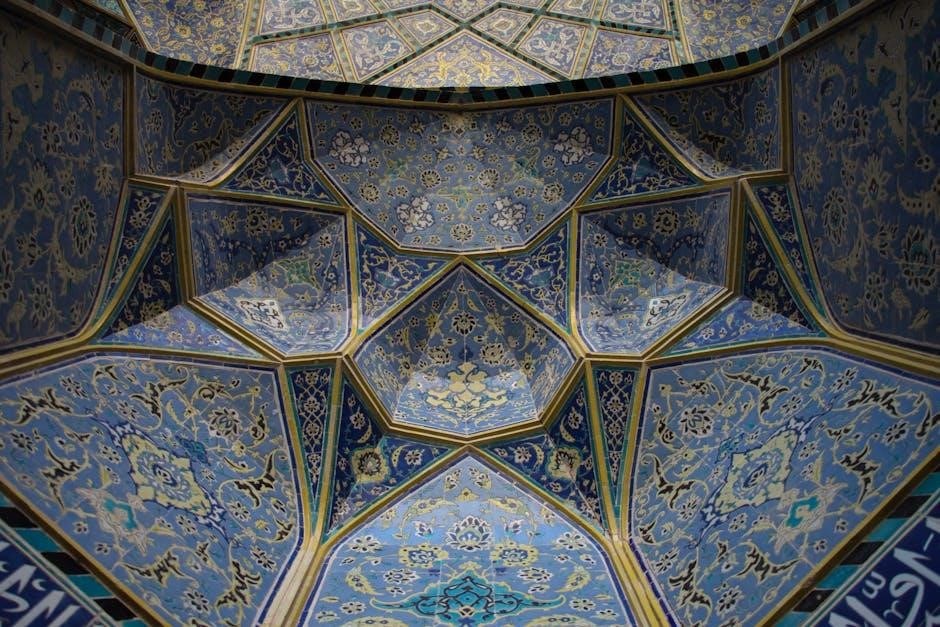
The Persian Tiles crochet design draws inspiration from traditional Persian ceramics, Moroccan textiles, and architecture, blending vibrant colors and geometric patterns into a modern, unique crochet piece.
3.1. Traditional Persian Ceramic Patterns
Traditional Persian ceramic patterns are renowned for their intricate geometric shapes, floral motifs, and vibrant color schemes. These designs have inspired the Persian Tiles Crochet Pattern, capturing the essence of ancient artistry. The use of symmetry and repeating motifs in ceramics translates beautifully into crochet, creating a sense of harmony and balance. The rich color palettes, often featuring deep blues, greens, and reds, evoke a timeless elegance. By drawing from these traditional patterns, crocheters can craft blankets that reflect the cultural and artistic heritage of Persian ceramics, blending history with modern creativity. This inspiration ensures that each stitch tells a story, connecting the past with the present.
3.2. Moroccan Textiles and Architecture Influence
Moroccan textiles and architecture have also played a significant role in shaping the Persian Tiles Crochet Pattern. The intricate geometric patterns, zellij tilework, and vibrant colors of Moroccan design complement the Persian aesthetic, creating a rich and layered visual experience. The interplay of shapes and hues in Moroccan architecture, such as arched doorways and tiled mosaics, adds a dynamic element to the crochet motifs. This influence allows crocheters to experiment with bold color combinations and intricate designs, resulting in a blanket that feels both exotic and timeless. By blending Moroccan and Persian elements, the pattern achieves a unique cultural fusion that captivates the eye and inspires creativity. This blend of influences ensures a truly distinctive and beautiful finished project.
3.3. Modern Interpretations of Classic Designs
Modern interpretations of the Persian Tiles Crochet Pattern offer fresh twists on traditional motifs, blending the classic elegance of Persian and Moroccan influences with contemporary style. Designers are experimenting with bold color palettes, asymmetrical layouts, and innovative yarn choices to create unique and trendy pieces. This modern approach allows crocheters to personalize the pattern, making it adaptable to various home decor styles. The result is a blanket that feels both rooted in history and distinctly modern, appealing to a wide range of tastes. By incorporating current design trends, the Persian Tiles pattern remains timeless while staying relevant in today’s craft community. This evolution ensures the pattern continues to inspire creativity and artistic expression among crocheters of all levels.
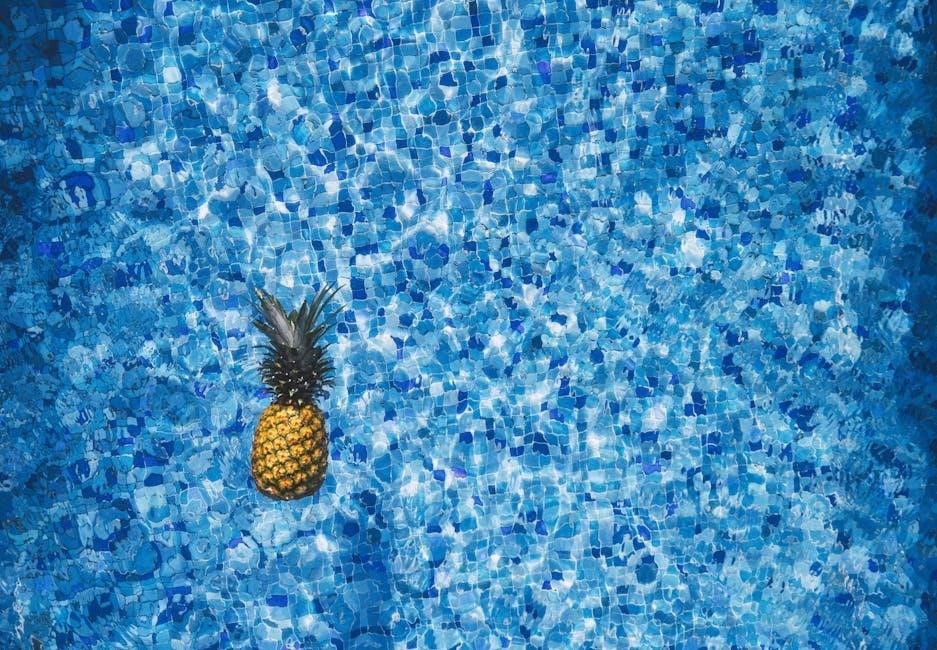
Materials and Tools Needed
To create the Persian Tiles crochet pattern, you’ll need medium-weight yarn, a size J (6.0mm) crochet hook, scissors, and a tapestry needle. Optional tools include stitch markers and a yarn cutter for convenience.
4.1. Recommended Yarn Types and Colors
For the Persian Tiles Crochet Pattern, medium-weight yarns are ideal, offering excellent stitch definition and drape. Acrylic yarns are recommended for their softness, durability, and wide color range, perfectly capturing the intricate motifs. Traditional color palettes feature deep blues, greens, reds, and golds, reflecting authentic Persian tile aesthetics. However, modern interpretations allow for flexibility, such as pastel hues for a softer look or monochromatic schemes for a contemporary vibe. Popular brands like Scheepjes and Lion Brand are suggested for their superior quality and diverse color options. Consider cotton or cotton blends for breathability, especially in warmer climates. Ensure to purchase extra yarn for adjustments and use smooth, solid colors to maintain sharp geometric patterns, avoiding variegated yarns that may distract from the design.
4.2. Hook Sizes and Types
The recommended hook size for the Persian Tiles Crochet Pattern typically ranges between 4mm and 5mm, depending on the yarn weight and desired tension. Aluminum or steel hooks are ideal for their smooth surface and consistent stitches, while ergonomic hooks can enhance comfort during long crochet sessions. Ensure to check the gauge before starting to maintain the pattern’s integrity. A larger hook may result in a looser fabric, while a smaller hook creates a denser weave. Experiment with hook sizes to achieve the perfect balance between drape and structure. Proper hook size selection is crucial for the moss stitch foundation and intricate octagon motifs, ensuring a professional finish. Always refer to the pattern’s specifications for optimal results.
4;3. Additional Tools for Crochet
Beyond the basics of yarn and hooks, several tools can enhance your crocheting experience. A tapestry needle is essential for weaving in ends seamlessly. Scissors are a must for cutting yarn as needed. Stitch markers help keep track of complex patterns, especially when working on intricate motifs like the octagon tiles. A yarn needle or large-eye needle is useful for sewing seams or joining motifs. Optional tools include a crochet clip or yarn clip to manage working yarn, and a measuring tape or ruler to check your gauge. These accessories ensure precision, organization, and ease while working on the Persian Tiles pattern, making the process more enjoyable and efficient.
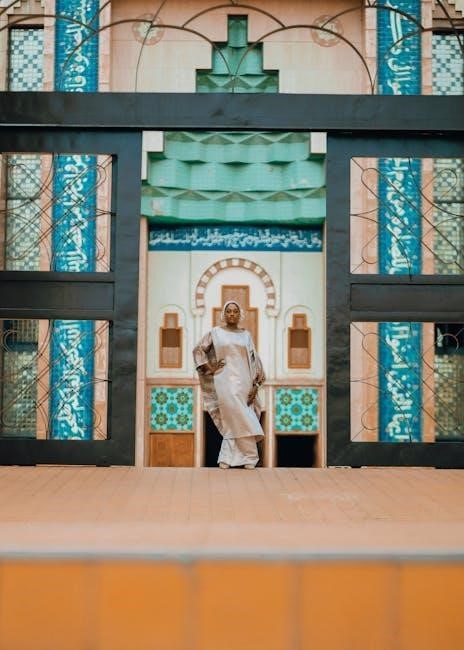
Step-by-Step Guide to Crocheting Persian Tiles
This guide provides a detailed, structured approach to creating the Persian Tiles pattern. Start by understanding the gauge and tension to ensure consistency. Construct the octagon motif, which forms the foundation of the design. Learn seamless joining techniques to connect motifs without visible seams. Explore adding color variations and patterns to enhance the visual appeal. Follow the step-by-step instructions carefully to achieve a professional finish. With patience and practice, you’ll master the intricate details and complete a stunning blanket that showcases your crochet skills beautifully.
5.1. Understanding the Gauge and Tension
Gauge and tension are crucial for achieving the desired size and drape in the Persian Tiles Crochet Pattern. Gauge refers to the number of stitches and rows per inch, ensuring the blanket fits as intended. Proper tension prevents the fabric from being too stiff or too loose, affecting both appearance and comfort. To measure gauge accurately, crochet a swatch using the recommended yarn and hook size. Count the stitches and rows in a 4×4 inch area to verify consistency. If your gauge is off, adjust the hook size or yarn weight. Maintaining even tension is key, especially when working with intricate motifs like the octagon tiles. Practice the moss stitch beforehand to master the rhythm and tension, ensuring a professional finish for your blanket.
5.2. Constructing the Octagon Motif
The octagon motif is the heart of the Persian Tiles Crochet Pattern, representing the traditional Persian ceramic designs. Begin by creating a foundation ring, then work in rounds, increasing stitches evenly to form the octagon shape. Use the moss stitch as the base, ensuring each round is seamless. Pay attention to stitch count accuracy to maintain the motif’s symmetry. As you progress, introduce color changes to mirror the vibrant tiles. Each octagon motif requires precision and patience, but the result is a stunning, intricate piece. Once completed, block the motif to enhance its shape and texture, preparing it for joining with others to form the full blanket design.
5.3. Joining Motifs Seamlessly
Joining the octagon motifs seamlessly is a critical step in creating a cohesive Persian Tiles blanket. Use a tapestry needle and yarn to weave in ends before joining. Align the edges of two motifs precisely, ensuring the stitches match perfectly. Employ the whipstitch or slip stitch to join the motifs, working from one edge to the other. Maintain consistency in color and orientation to preserve the design’s visual flow. For a nearly invisible seam, make sure the yarn color matches the motif edges. To enhance the finished look, block each motif before joining to ensure even tension and a professional appearance. This method ensures the blanket lies flat and the intricate patterns remain uninterrupted, resulting in a stunning, polished piece.
5.4. Adding Color and Pattern Variations
Adding color and pattern variations to your Persian Tiles crochet project allows for personalization and creativity. Experiment with vibrant yarn colors to reflect traditional Persian ceramics or Moroccan textiles. Consider using a gradient effect or contrasting hues to create visual interest. For a modern twist, incorporate geometric patterns or subtle texture variations within the octagon motifs. To maintain harmony, choose a cohesive color palette that complements the overall design. Additionally, you can introduce subtle shifts in stitch patterns, such as alternating between moss stitch and other textures, to add depth. Personalizing the design ensures your blanket is unique and reflects your artistic vision, making it a standout piece in any room.
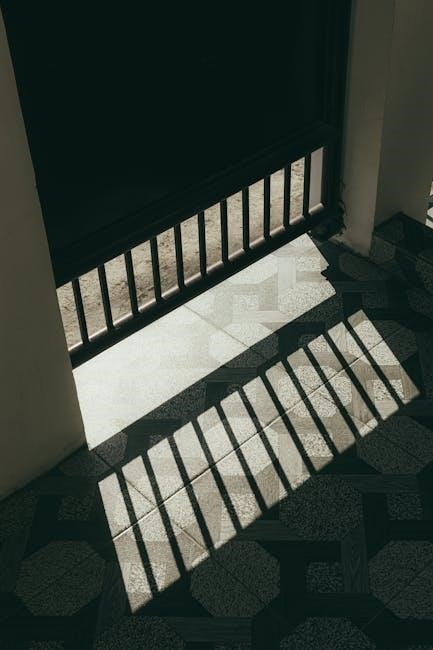
Tips for Success in Crocheting Persian Tiles
Ensure consistent tension, use high-quality yarn, and maintain precise stitch counts. Regularly check your work and weave in ends as you go for a polished finish.
6.1. Choosing the Right Color Palette
Selecting the perfect color palette is essential for capturing the vibrant spirit of the Persian Tiles Crochet Pattern. Inspired by traditional Persian ceramics, this design thrives on bold, contrasting hues that create a striking visual impact. Earthy tones like terracotta, emerald, and sapphire are ideal for replicating authentic ceramic patterns. For a modern twist, consider experimenting with pastels or metallic shades to add a contemporary flair. The moss stitch base allows colors to shine, so choose a palette that complements your yarn selection. Balance warm and cool tones to ensure harmony in your blanket. Remember, the color palette is what brings this intricate design to life, making it a true masterpiece of crochet artistry.
6.2. Managing Yarn Quantities and Ends
Effective yarn management is crucial to ensure your Persian Tiles Crochet Pattern project runs smoothly. Calculate yarn quantities based on the number of motifs and colors chosen, as each octagon may require specific amounts. Keep track of leftover yarn to minimize waste, and consider using a yarn calculator for accuracy. To avoid excess ends, weave them in as you go or use a yarn needle to sew them neatly. For multi-color designs, work in ends during the joining process to maintain a clean finish. Always have a little extra yarn for adjustments and seams. Proper yarn management ensures your blanket remains cohesive and visually stunning, with no stray ends to distract from its beauty.
6.3. Mastering the Moss Stitch
Mastery of the moss stitch is essential for the Persian Tiles Crochet Pattern, as it forms the foundation of the design. The moss stitch, also known as the linen stitch, creates a soft, fabric-like texture that complements the vibrant colors and intricate motifs. To master it, start by practicing the basic single crochet and chain stitches, ensuring even tension to maintain consistency. Swatch before beginning your project to confirm gauge. As you work, keep track of your stitches to avoid miscounts. The moss stitch’s simplicity makes it accessible to beginners, while its versatility appeals to experienced crocheters. Regular practice will help you achieve a smooth, professional finish, enhancing the overall beauty of your Persian Tiles blanket. Patience and consistency are key to perfecting this stitch.
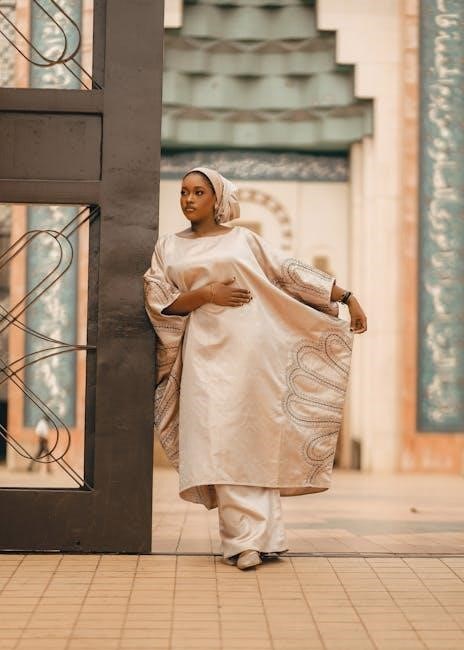
Variations and Customization Ideas
Customize your Persian Tiles blanket with vibrant colors, unique motifs, or embellishments. Explore size adjustments, shape variations, and personalized patterns for a truly one-of-a-kind design that reflects your style.
7.1. Adding Embellishments and Beads
Enhance your Persian Tiles crochet project by incorporating embellishments and beads for a luxurious finish. Beads can be added to motif centers or along edges for a dazzling effect. Consider using small, colorful beads that complement your yarn palette to create a modern, eye-catching design. You can sew beads onto completed motifs or crochet them directly into the fabric as you work. This technique adds texture and visual interest, making your blanket truly unique. For a subtle touch, try using metallic beads to mimic the shimmer of traditional Persian ceramics. Experiment with bead placement to create patterns or accents that highlight the intricate tile designs. This step allows you to personalize your project, transforming it into a one-of-a-kind masterpiece.
7.2. Creating Different Sizes and Shapes
Customize your Persian Tiles project by adjusting sizes and shapes. Using different hook sizes or yarn weights can enlarge or reduce motif dimensions. Adding more motifs increases the blanket’s size, while fewer motifs create smaller, delicate pieces. Experiment with shapes by arranging motifs in unique layouts or adding decorative borders to form circles, triangles, or other forms. Adjusting your stitch tension can also subtly alter the overall size. This versatility makes the pattern adaptable for various projects, from cozy baby blankets to stylish lap blankets or decorative wall hangings. For added personalization, consider integrating elements from other crochet patterns to create a truly unique design that showcases your creativity and skill.
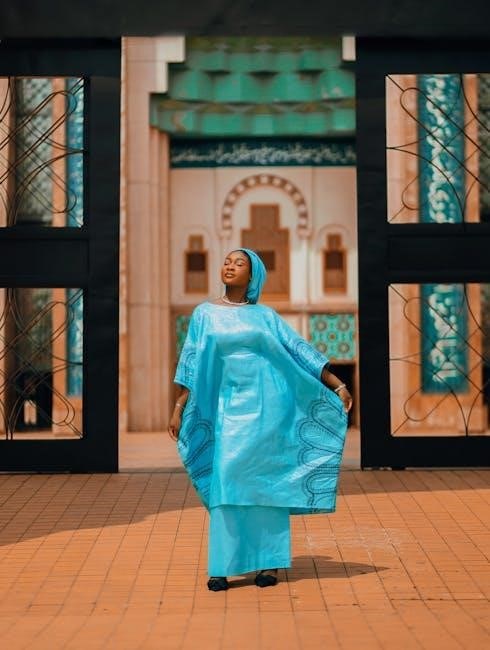
The Importance of Stitch Guide and Diagrams
A stitch guide and diagrams are essential for mastering the Persian Tiles Crochet Pattern. They provide clear visual instructions, ensuring that each motif is crocheted correctly. Diagrams illustrate how to construct intricate octagon shapes and join them seamlessly, while stitch guides offer step-by-step instructions for tension and gauge. These resources are particularly helpful for understanding color changes and intricate patterns. By following the guide, crocheters can achieve the vibrant, multi-colored designs that define this pattern. Diagrams also highlight how to manage yarn ends and maintain consistency, making the process smoother. Whether you’re a beginner or an experienced crocheter, these tools ensure accuracy and confidence, helping you create a professional-looking blanket with ease.
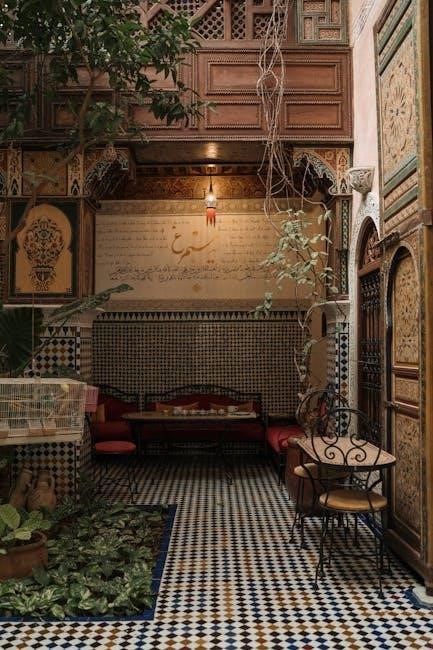
Community and Sharing Your Finished Project
Sharing your finished Persian Tiles project with crochet communities fosters inspiration and connection. Post your creations on social media platforms like Instagram or Facebook to receive feedback and admiration. Joining crochet clubs or groups allows you to showcase your work and gain motivation from fellow enthusiasts. Additionally, consider gifting your blanket or selling it to appreciate the effort and love invested in its creation. The joy of crafting is amplified when shared with others who understand the dedication behind each stitch.
9.1. Joining Crochet Clubs and Groups
Joining crochet clubs or online groups is an excellent way to connect with fellow enthusiasts who share your passion for the Persian Tiles pattern. These communities offer support, inspiration, and motivation, helping you stay engaged throughout your project. Members often share tips, resources, and feedback, creating a collaborative environment that enhances your crochet journey. Many clubs host challenges or charity initiatives, allowing you to contribute to meaningful causes while honing your skills. Additionally, clubs provide opportunities to learn from experienced crocheters and gain insights into new techniques or variations of the Persian Tiles design. Being part of a group can also help you stay accountable and motivated, ensuring your project progresses smoothly. Whether in-person or virtual, these communities are invaluable for fostering creativity and camaraderie among crocheters.
9.2. Sharing on Social Media Platforms
Sharing your Persian Tiles crochet project on social media platforms like Instagram, Facebook, and Pinterest is a great way to showcase your creativity and connect with other crochet enthusiasts. These platforms allow you to post progress updates, share tips, and inspire others with your unique interpretation of the pattern. Using hashtags like #PersianTilesCrochet or #CrochetCommunity can help your work gain visibility and attract feedback from fellow crafters. Many creators share their finished projects, often accompanied by stunning photos, which can serve as inspiration for others. Engaging with online communities in this way not only fosters connections but also provides a sense of accomplishment and pride in your work. Sharing your journey can also encourage others to try the pattern and join the crochet community.
9.3. Gifting or Selling Your Finished Blanket
Your Persian Tiles crochet blanket can make a thoughtful gift for loved ones or a unique product to sell. Many crafters choose to gift their finished projects to family and friends, who appreciate the time and effort put into creating such a vibrant and intricate design. Others opt to sell their blankets on platforms like Etsy or at local craft fairs, attracting customers who admire handmade, high-quality items. If selling, consider pricing based on materials, time, and the blanket’s size. Sharing your finished project can also help promote your skills and attract potential buyers or commission requests. Whether gifting or selling, your Persian Tiles blanket is a testament to your creativity and dedication to crochet art.
The Persian Tiles Crochet Pattern is a rewarding project that combines cultural inspiration with modern crochet techniques. Its vibrant colors and intricate octagon motifs create a stunning blanket that stands out. Whether you’re a seasoned crocheter or a novice, this pattern offers a fulfilling experience. The availability of free PDFs and resources makes it accessible to everyone. By following the steps and tips shared, you can create a beautiful blanket that reflects your personal style. Crocheting is not just about crafting; it’s about creating something meaningful. The Persian Tiles pattern is a celebration of creativity, tradition, and the joy of making something with your own hands. Embrace the process, and enjoy the satisfaction of completing your unique piece of crochet art.